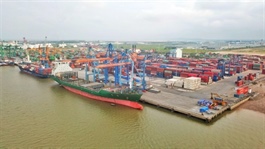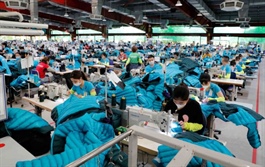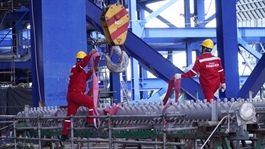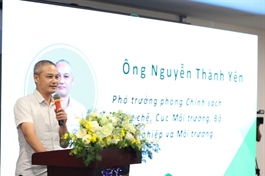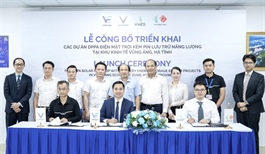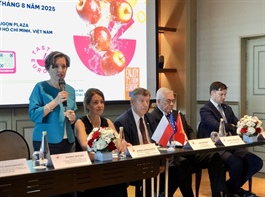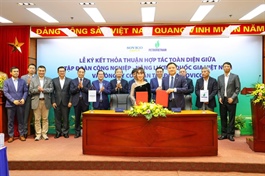Green shift opens new chapter for Việt Nam’s packaging and recycling industries
Green shift opens new chapter for Việt Nam’s packaging and recycling industries
Under mounting pressure from international markets and stricter domestic regulations, sustainable packaging is taking centre stage, not as a passing trend but as a commercial imperative.
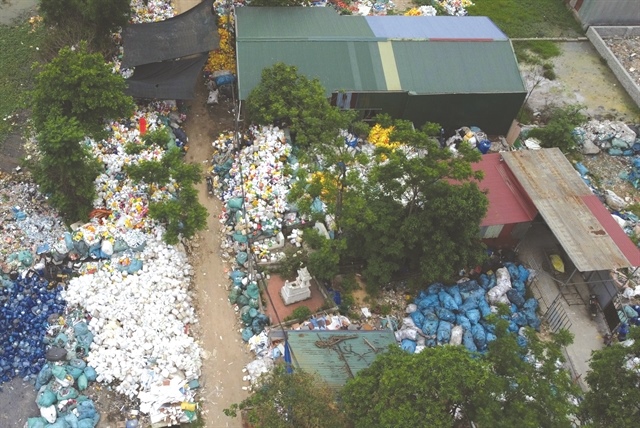
ALL IN ONE SPOT: Collected scrap piled up at Ứng Thiên Commune in the capital. VNA/VNS Photo |
As Việt Nam accelerates its green growth agenda, a promising window of opportunity is opening for the packaging and recycling industries.
With the Extended Producer Responsibility regulation officially in effect since early 2024, both local and foreign businesses face a defining moment: one that compels not only compliance with environmental mandates, but also a strategic rethinking of business models to align with circular economy goals and long-term global competitiveness.
For years, packaging waste has been a growing environmental concern in Việt Nam. Now, under mounting pressure from international markets and stricter domestic regulations, sustainable packaging is taking centre stage, not as a passing trend but as a commercial imperative.
Eco-designed, recyclable packaging is rapidly becoming a prerequisite, particularly in export-linked sectors. Enterprises that lag behind in adapting risk exclusion from global supply chains.
What makes green packaging a critical entry point into Việt Nam’s circular transition is its unique capacity to link stakeholders across the entire product lifecycle.
From material sourcing and product design to post-consumer collection and recycling, sustainable packaging has the potential to mobilise investment, spark innovation and foster cross-sector collaboration. It is an essential pillar in the country’s ambition to build a low-impact, high-value economy.
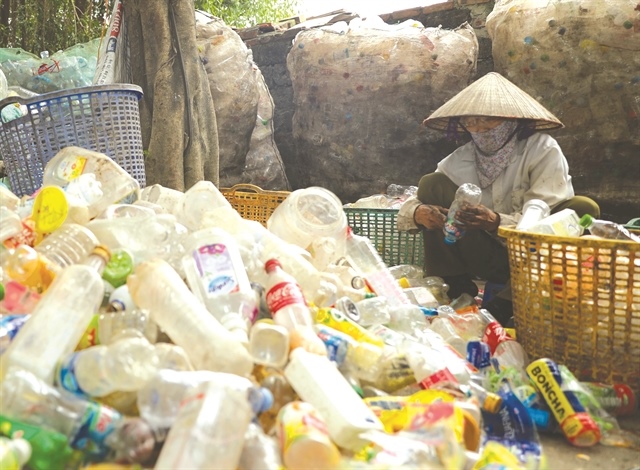
ALL IN ONE SPOT: Collected scrap piled up at Ứng Thiên Commune in the capital. VNA/VNS Photo |
According to the former Ministry of Natural Resources and Environment [which has been merged with the Ministry of Agriculture and Rural Development under the name the Ministry of Agriculture and Environment], Việt Nam produces around 1.8 million tonnes of plastic waste and packaging annually. This challenge has been magnified by the surge in e-commerce, where plastic styrofoam and single-use bags dominate last-mile delivery and are typically discarded after just one use.
Meanwhile, consumer attitudes are shifting. Environmental degradation has heightened public awareness, turning green consumption from a niche preference into a lifestyle choice.
A 2024 survey by Vietnam Report found that 92.1 per cent of consumers were concerned about the environmental impact of packaging, an increase of 12.5 percentage points from the previous year.
Another report from the same group also showed that 57.4 per cent of respondents said they were willing to pay more for eco-friendly packaging, provided the premium remains reasonable.
"I’ve changed my habits over the past two years," Kim Ngân, a 29-year-old office worker, told Việt Nam News.
"Now, I prefer takeaway drinks from shops that use environmentally friendly cups and straws instead of plastic ones."
Central to this shift is the principle of eco-design, reimagining packaging from the outset to ensure it can be easily collected, sorted and recycled.
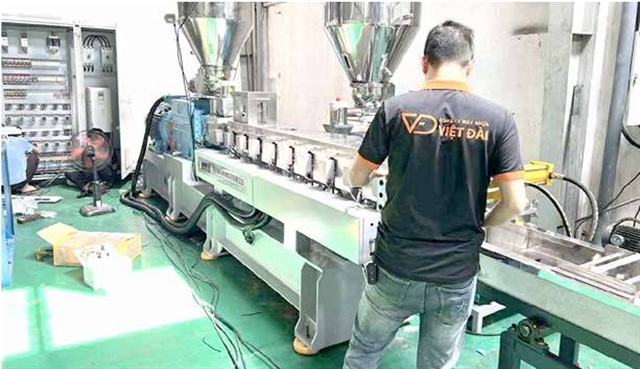
ALL IN ONE SPOT: Collected scrap piled up at Ứng Thiên Commune in the capital. VNA/VNS Photo |
Eco-design is not just about reducing waste. It integrates sustainability into the core of product development, minimising both environmental footprint and operational costs.
With over 6,000 packaging businesses nationwide, as reported by the General Statistics Office, many companies are steadily pivoting towards greener alternatives to meet rising international demand. This transition is laying a strong foundation for the sustainable growth of Việt Nam’s packaging sector.
Among the industry frontrunners is the DUYTAN Plastic Corporation (DUYTAN Recycling), which has invested in a bottle-to-bottle recycling plant in Tây Ninh Province.
The facility, with an annual capacity of 100,000 tonnes, converts used PET bottles into food-grade plastic pellets. Since 2020, the company has recycled over 80,000 tonnes of plastic waste, equivalent to around six billion bottles, primarily for export.
According to DUYTAN Recycling sustainability director Lê Anh, domestic demand is also gaining momentum as beverage and dairy brands work towards a target of incorporating at least 50 per cent recycled plastic by 2030. Yet, cost remains a challenge. Green packaging still costs 10–20 per cent more than conventional options.
"We need to tell the green story through concrete actions, from R&D and eco-design to investing in modern machinery that reduces production costs and differentiates our products," Anh said.
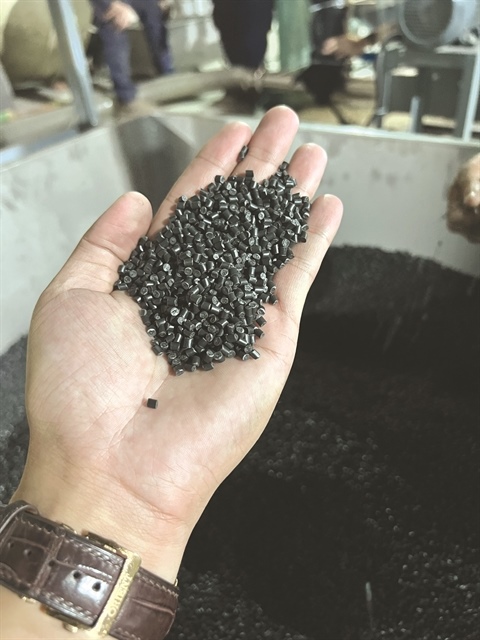
ALL IN ONE SPOT: Collected scrap piled up at Ứng Thiên Commune in the capital. VNA/VNS Photo |
Nguyễn Văn Trung, deputy director of Viet Dai Plastic Machine Co Ltd, told Việt Nam News that his company provided equipment capable of processing a wide range of commonly used plastics in the country, such as PP, PE and PET, especially types in high demand for recycling.
"Our machinery helps remove impurities and dust, producing high-quality pellets suitable for reuse," he said.
He added that the demand for plastic recycling machines was growing rapidly, but with increasingly strict technical requirements.
"The equipment must ensure that both gas emissions and wastewater from the recycling process are clean and environmentally compliant. This demand is pushing us to innovate continuously," he said.
To stay competitive, Trung said that the company regularly sent engineers to mainland China, Taiwan, Japan and Australia to learn advanced recycling technologies and bring them back to Việt Nam.
"Environmental regulations and green development trends are accelerating the pace of innovation in this field. Our machines must become more sophisticated year after year," he said.
Based on orders for the firm’s equipment, he also pointed to key recycling hubs in Hưng Yên, Hải Phòng, Bắc Ninh and Tây Ninh, where demand for recycling machines is growing by 10–20 per cent annually.
In an encouraging development, many small and medium-sized enterprises (SMEs) in Việt Nam are scaling up and professionalising their operations.
"We’ve seen significant investment in modern machinery and facility upgrades. Many SMEs now meet environmental standards in plastic waste recycling," Trung said.
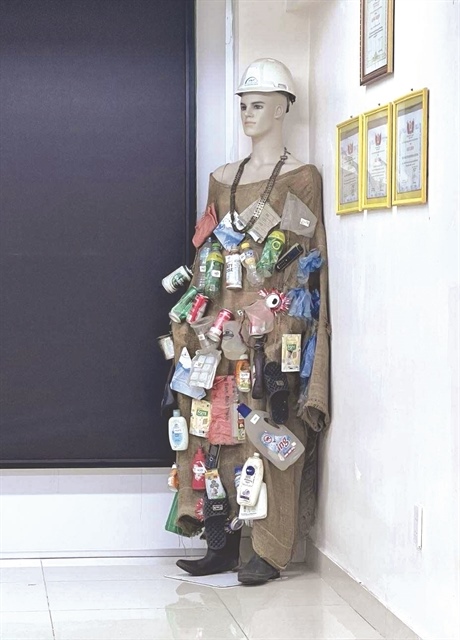
ALL IN ONE SPOT: Collected scrap piled up at Ứng Thiên Commune in the capital. VNA/VNS Photo |
The push for sustainable practices extends beyond manufacturers. Major consumer brands are actively revising their packaging strategies in response to consumer expectations and environmental, social and governance imperatives.
Nestlé Vietnam, for example, has committed to making more than 95 per cent of its packaging recyclable by 2025. The company also plans to cut its use of virgin plastics by a third and is investing in better systems for collection, sorting and recycling.
The company's efforts include eliminating problematic packaging, replacing over 95 per cent of pallet surfaces, reducing plastic wrap and improving the environmental performance of B2B packaging. Nestlé also aims to enhance the value and recyclability of packaging types currently recycled at scale.
On the international market, demand for sustainable Vietnamese packaging is on the rise.
According to Alibaba.com Vietnam, search volume for packaging and printing products from Vietnamese suppliers has jumped by over 70 per cent year-on-year. Products such as paper boxes, bamboo and wood-based containers, biodegradable straws, and single-use paper cups are especially popular among global buyers.
"Việt Nam is emerging as a leader in sustainable packaging, thanks to its fast adaptation and continuous product innovation," a representative from Alibaba.com noted.
The country’s conversion rate from product views to orders in this sector currently stands at 8.94 per cent, well above the industry average.
- 07:31 10/08/2025





